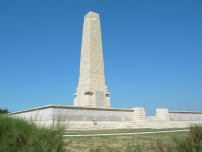| First Name: | John | Last Name: | PEARCE | |
|---|---|---|---|---|
| Date of Death: | 09/08/1915 | Lived/Born In: | Richmond-on-Thames | |
| Rank: | Sergeant | Unit: | Royal Munster Fusiliers6 | |
| Memorial Site: | 1. Richmond-on-Thames Memorial 2. Helles Memorial, Gallipoli | |||
Current Information:Born-Putney
Gallipoli 1915 On 25 April, British, Australian and New Zealand forces landed on the Gallipoli peninsula . The plan was that these forces would soon defeat a demoralised Turkish army, knock Turkey out of the war, open up the Mediterranean to the Russian navy and threaten Austro-Hungary from the south. None of these things were achieved despite nine months of hard fighting in terrible conditions. It was a heroic failure. By July, 1915, and after much fierce fighting, stalemate had set in at Gallipoli both at Cape Helles where the British and French had landed and at Anzac Cove where the Australian and New Zealand Corps were unable to break out of their beach head. Fresh troops were needed and they were on their way in the shape of four divisions from Britain and things were put on hold until they arrived. The plan for August was for a landing at Suvla Bay to the north of Anzac Cove whilst at the same time, the ANZAC Corps, reinforced by some of the new British troops would effect a breakout from Anzac Cove and establish a line across the peninsula. Whilst this was going on the troops in the south at Helles would stage a number of diversionary attacks. But it all went horribly wrong and much of the reason for this can be explained by inadequate planning and leadership. Nobody seemed to know what they were supposed to be doing and Lieutenant-General Stopford, in charge of the Suvla landings was particularly out of his depth. The landings at Suvla failed to link up with the forces at Anzac and the breakout from there did not happen despite valiant efforts by all concerned. The loss of life on all fronts was again enormous. L.A. Carlyon’s excellent book “Gallipoli” gives a superb yet chilling account of the events. The 6th Royal Munster Fusiliers battalion of 30 Brigade, 10th Division landed in the northern part of Suvla Bay on 7th August where some mines laid on the beach caused a few casualties. Once ashore, they were one of the battalions that began their advance up the Kiretch Tepe Sirt ridge of hills running along the northern side of Suvla Bay. But progress was slow and a major effort was ordered for 9th August by a force that included the 6th Royal Munster Fusiliers. Despite the fact that their rations and water had not yet arrived, they began their advance at 7.30am, supported by fire from the guns of Royal Navy ships. 6th Munster moved along the crest of the ridge until confronted by a Turkish stronghold which gun fire from HMS Grampus subdued and allowed them to make another short advance at the end of which they captured another small enemy post, subsequently named Jephson’s Post But here all further progress came to an end for which Turkish resistance, extreme fatigue and shortage of water were all responsible. 6th Munster suffered a number of casualties during this day’s operations, one of whom was John Pearce. |
||||
| « Back to Search Results | ||||
| If you think any of the information shown here is incorrect, Click Here to submit your amends and comments | ||||




